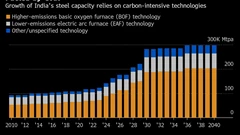China Seeks to Boost Power Grids as Sichuan Reservoirs Run Dry
(Bloomberg) -- China’s top energy officials are calling for the addition of more power-generation capacity and cross-province grids as a severe drought drains Sichuan’s main reservoirs, prompting outages and shutting down key factories.
The National Energy Administration acknowledged supply challenges caused by high temperatures and a lack of hydroelectricity generation in a statement reviewing its power system.
China will accelerate hydro and nuclear power projects while pushing for more transmission lines across regions and expanding renewable capacity such as wind and solar in the next few years, the agency said. It pledged to balance supply and demand nationwide by 2025.
Sichuan, which relies on hydropower for 82% of its power generation, is seeing its worst drought in more than a half century as temperatures have soared above 40 degrees Celsius (104 degrees Fahrenheit). Water levels in its main reservoirs have reached bottom, more than halving hydropower capacity, Zhou Jian, deputy chief engineer of State Grid Sichuan’s regulation and control center, said in an interview with state broadcaster CCTV.
The province has activated its highest emergency response and ordered industrial production halts to ensure that electricity can be supplied to households, impacting the supply of automobile parts and key materials. City street lamps are “lit every other day,” while shopping malls, subways and office buildings have turned off display lighting for advertising and landscaping, CCTV reported.
The extreme weather isn’t limited to Sichuan. China has sent the highest alerts for hot weather for 32 days through Aug. 21. More than 2,000 enterprises in Wuhan have responded to the call to save electricity in the past week, according to local media reports.

Other parts of the country are facing different weather-related challenges. Northern China is seeing heavy rainfalls and deadly floods, shutting down mines and disrupting coal transportation. The southeastern province of Guangdong later this week is expected to see Ma-on, a tropical storm that is moving up from Southeast Asia.
The impact of the severe weather is reverberating through energy and commodity markets. Scorching heat and drought have become the biggest threat for China’s autumn harvest, as rice and corn plantations in the south were hit hard, according to the Ministry of Agriculture and Rural Affairs.
Sichuan is seeking help to buy more energy from other provinces, and local coal miners have received government emergency calls to boost output. Sichuan Coal Industry Group said it has shifted more work to night time to save power, and it has more than doubled the thermal coal supply.
But the province lacks the coal capacity to cover the gap from the drop in hydro production, BloombergNEF analyst Nannan Kou said in an interview with Bloomberg Television. It’s also a power exporter, so it doesn’t have the infrastructure to receive enough from other regions.
“The situation is only going to get better when the weather conditions are eased,” Kou said.
Temperatures in Sichuan are expected to remain high Tuesday and Wednesday before rain and cooler weather arrives from Thursday.
Some companies that shut down production last week are slowly restarting operations in the region. Toyota Motor Corp. said it was gradually resuming production at its plant in Chengdu on Monday. Robert Bosch GmbH said output at its auto-parts facility in the city has resumed, while manufacturing at its power-tools site is still disrupted.
But the impact for many sectors may linger. The province is a major producer of polysilicon, a major component of solar panels, and lithium chemicals used in electric vehicle batteries. Both products had already seen prices skyrocket even before the drought because of strong energy transition demand.

About 5,000 to 7,000 tons of lithium production is impacted at the moment, and if disruptions continue for longer it may force cathode producers and eventually battery makers to scale back output, Rystad Energy analyst Susan Zou said in a Bloomberg Television interview.
“Even if there’s no further extension of power cuts from Friday, lithium producers may not be able to immediately resume full operational rates,” she said.
(Updates throughout.)
More stories like this are available on bloomberg.com
©2022 Bloomberg L.P.
KEEPING THE ENERGY INDUSTRY CONNECTED
Subscribe to our newsletter and get the best of Energy Connects directly to your inbox each week.
By subscribing, you agree to the processing of your personal data by dmg events as described in the Privacy Policy.
More renewables news

GE Vernova to Power City-Sized Data Centers With Gas as AI Demand Soars

Longi Delays Solar Module Plant in China as Sector Struggles

Australia Picks BP, Neoen Projects in Biggest Renewables Tender

SSE Plans £22 Billion Investment to Bolster Scotland’s Grid

A Booming and Coal-Heavy Steel Sector Risks India’s Green Goals

bp and JERA join forces to create global offshore wind joint venture

Blackstone’s Data-Center Ambitions School a City on AI Power Strains

Chevron Is Cutting Low-Carbon Spending by 25% Amid Belt Tightening

Free Green Power in Sweden Is Crippling Its Wind Industry
















